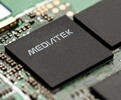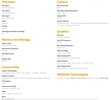Mediatek MT6592 vs MediaTek Helio X27 MT6797X
Mediatek MT6592
► remove from comparison
The MediaTek MT6592 is a mid-range 28 nm SoC for Android smartphones and tablets. It was announced near the end of 2013 and is manufactured in 28 nm. It includes 8 Cortex-A7 processor cores that are typically clocked up to 1.7 - 2.0 GHz. Furthermore, the SoC integrates an ARM Mali-450 GPU at 700 MHz, WLAN, a video decoder for up to 4K content, a LPDDR3 memory controller at 666 MHz, and a 2G/3G (UMTS/HSPA+) radio.
Although the MT6592 offers eight relatively high clocked CPU cores compared to other SoCs, its performance in day-to-day usage is a bit lower, as the Cortex-A7 cores offer slower performance per clock and only a few apps are able to make use of all 8 cores simultaneously. Modern dual-core (e.g., Apple A7) or quad-core (e.g., Cortex A15 or Snapdragon 800) SoCs can be clearly faster in everyday scenarios.
The integrated ARM Mali-450 MP4 GPU offers 4 graphics clusters that are clocked at a high 700 MHz. However, the performance of the GPU is somewhat below that of a Tegra 4 or Adreno 320. Also like the Nvidia rival, the Mali-450 lacks support for OpenGL ES 3.0.
MediaTek Helio X27 MT6797X
► remove from comparison
The Mediatek Helio X27 MT6797X is an upper mainstream ARM SoC for smartphones (mainly Android based). It is manufactured in a 20 nm process and is equipped with 10 CPU cores. Two fast Cortex-A72 cores are running at up to 2.6 GHz (performance), four Cortex-A53 cores at up to 2 GHz (balanced) and four Cortex-A53 cores at up to 1.6 GHz (efficiency). All cores support 64-bit and the utilization of three clusters is supposed to improve efficiency according to Mediatek. The two A72 cores are only designed for short "Burst-Performance scenarios" according to Mediatek and are probably not used for sustained workloads. Compared to the similar named MT6797, the MT6797X was introduced later and offers higher clock speeds for CPU and GPU.
The integrated ARM Mali T880 MP4 (according to Wikipedia) GPU is clocked at up to 875 MHz and has four cluster (from 16) from the Midgard (4th Gen) architecture.
The chip also includes an LTE modem (Cat. 6 300/50 Mbps, DC-HSPA+, TD-SCDMA, EDGE, CDMA2000, ...) as well as a WLAN 802.11ac (280 Mbps) modem. GPS/Glonass/BeiDou is supported for location. The integrated video encoder can handle up to 4Kx2K H.265 at 30 fps and HDR. The SoC can also decode H.265, H.264 and VP9 in 4K30.
Power Consumption
The processor is manufactured in a 20 nm process at TSMC and should have an average power consumption under load.
| Model | Mediatek MT6592 | MediaTek Helio X27 MT6797X | ||||||||||||||||||||||||||||||||||||||||||||||||
| Codename | Cortex-A7 | |||||||||||||||||||||||||||||||||||||||||||||||||
| Series | Mediatek | Mediatek Mediatek Helio 20 | ||||||||||||||||||||||||||||||||||||||||||||||||
| Series: Mediatek Cortex-A7 |
| |||||||||||||||||||||||||||||||||||||||||||||||||
| Clock | 1700 - 2000 MHz | 2600 MHz | ||||||||||||||||||||||||||||||||||||||||||||||||
| L1 Cache | 512 KB | |||||||||||||||||||||||||||||||||||||||||||||||||
| L2 Cache | 1 MB | |||||||||||||||||||||||||||||||||||||||||||||||||
| Cores / Threads | 8 / 8 | 10 / 10 | ||||||||||||||||||||||||||||||||||||||||||||||||
| Technology | 28 nm | |||||||||||||||||||||||||||||||||||||||||||||||||
| Features | UMTS/HSPA+, TD-SCDMA, WiFi (802.11n), 666 MHz LPDDR3, 16 MP Camera ISP, 4K Video Encoder, H.265, GPS, NFC, ARM Mali-450 MP4 @ 700 MHz | 2x Cortex-A72 2.6 GHz (Performance), 4x Cortex-A53 2 GHz (Balance), 4x Cortex-A53 1.6 GHz (Efficiency) | ||||||||||||||||||||||||||||||||||||||||||||||||
| iGPU | ARM Mali-450 MP4 (700 MHz) | ARM Mali-T880 MP4 ( - 875 MHz) | ||||||||||||||||||||||||||||||||||||||||||||||||
| Architecture | ARM | ARM | ||||||||||||||||||||||||||||||||||||||||||||||||
| Announced | ||||||||||||||||||||||||||||||||||||||||||||||||||
| Manufacturer | www.mediatek.com | www.mediatek.com | ||||||||||||||||||||||||||||||||||||||||||||||||
Benchmarks
Average Benchmarks Mediatek MT6592 → 100% n=7
Average Benchmarks MediaTek Helio X27 MT6797X → 215% n=7
* Smaller numbers mean a higher performance
1 This benchmark is not used for the average calculation












